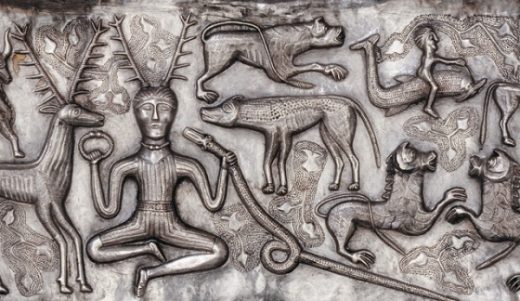Sunken treasures from ancient Egypt heading to British Museum

A diver with a large tablet carrying a royal decree from the pharaoh Nectanebo I, which will feature in the British Museum exhibition. Photograph: Christoph Gerigk/Franck Goddio/Hilti Foundation
Mark Brown Arts correspondent
More than 200 spectacular ancient Egyptian treasures buried beneath the Mediterranean seabed for more than 1,000 years are to travel to the British Museum for a blockbuster exhibition in 2016.
The museum announced a six-month show that will tell the remarkable story of two lost cities at the mouth of the Nile – Thonis-Heracleion and Canopus – which by the 8th-century AD had been swallowed completely by the sea.
Underwater archaeologists have been slowly excavating the area since 1996 and the loans will range from the enormous, a 5.4-metre-high granite statue of the Nile flood god Hapi, to the domestic.
Franck Goddio, who has led the archaeological team methodically digging and vacuuming off the seabed sands, said he was delighted to be showing the discoveries at the British Museum. “I have a dream that the visitor, who will see the artefacts, graphics and maps, will have the same pleasure that we had when we discovered them in the water.”
Ancient Egyptian underwater treasures to be exhibited for the first time
The exhibition will be the first at the British Museum to explore underwater archaeology. As well as the sunken treasures, there will be important loans from Egyptian museums that have rarely be seen outside Egypt.
It will tell the story of two great, Venice-like cities founded during the 7th-century BC that became important cultural melting pots with the arrival of Greek traders and mercenaries.
Aurélia Masson-Berghoff, who is co-curating the show with Goddio, said: “The groundbreaking discoveries which will be seen in the UK for the first time have completely transformed our understanding of the interaction between these great civilisations.”
Because they have been underwater for 1,000 years, most of the objects are in astonishing, pristine condition.
One recent find is a beautiful, sexy statue of Arsinoe II, who was the eldest daughter of Ptolemy I, founder of the Ptolemaic dynasty. The Cleopatra of her day, she became queen after marrying her brother, Ptolemy II, and was deified on her death – known and loved by both Egyptians and Greeks.
She is represented as an incarnation of the goddess of beauty, Aphrodite, and her statue would have adorned all Egypt’s temples. Here she is beautiful, dignified and striking, said Masson-Berghoff. “She was really famous, everyone knows Cleopatra but Arsinoe was another mythical queen of the Ptolemaic dynasty.
“She is absolutely fantastic and personally it is my favourite piece in the whole show.”
The statue is without a head, although hope remains that it will be found as the underwater project continues.
One of the biggest exhibits will be the colossal 6-tonne red granite statue of Hapi, the god of the annual flooding of the Nile, a symbol of abundance and fertility. It will be one of the first things visitors to the show see and give “a warm, if imposing” welcome, said Masson-Berghoff.

The 6-tonne red granite statue of Hapi, the god of the annual flooding of the Nile. Photograph: Christoph Gerigk/Franck Goddio/Hilti Foundation
The exhibition covers the centuries when Greeks were welcomed as privileged guests of the Egyptian pharaohs and the 300 years after Alexander the Great, when Greek kings and queens ruled, adopting and adapting Egyptian beliefs and rituals to legitimise their reign.
It represents Egypt’s first major loan of antiquities since the country’s revolution in 2011 and is particularly timely, said Egypt’s ambassador to the UK, Nasser Kamel. Just as the Mediterranean was a sea of cooperation a millennia ago, he hoped the exhibition would help promote cooperation and tolerance today.
The two cities have been known about because of ancient texts, but they were only discovered by Goddio and his Institut Européen d’Archéologie Sous-Marine two decades ago.
They have been working at the site every year, even during the Arab spring, Goddio said.
One of the first things divers discovered was an enormous walled temple at Thonis-Heracleion and a week later a fantastically well-preserved stela (or large tablet) on which a 380BC royal decree from the pharaoh Nectanebo I was advertised. The stela, which will travel to London, stated that 10% of the taxes collected on all goods imported from the “Sea of the Greeks” into the city were to be donated to an Egyptian temple.
The project will continue, said Goddio, although the vast majority of the two cities’ treasures will remain buried. “In the 19th century when an excavation was done, you excavate everything. Now we try to learn as much as we can by touching as little as we can.”
The BP Exhibition Sunken Cities: Egypt’s Lost Worlds will be at the British Museum from 19 May to 27 November 2016



